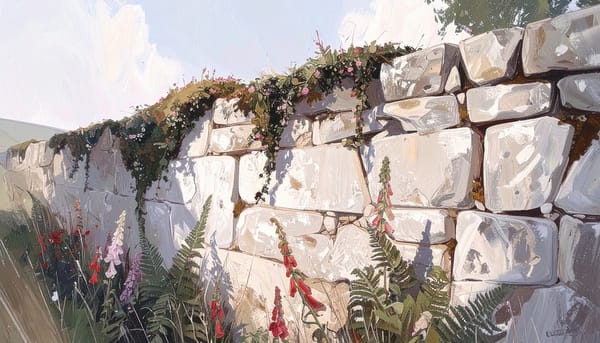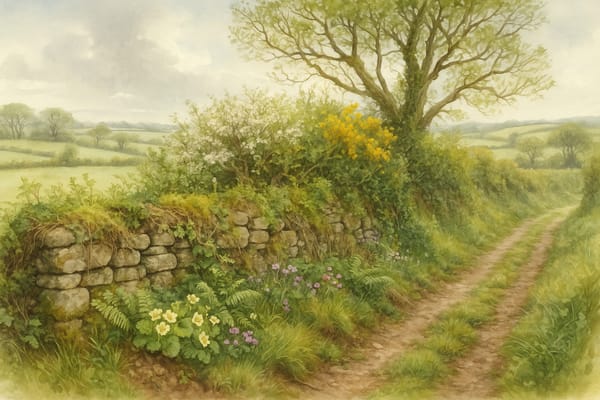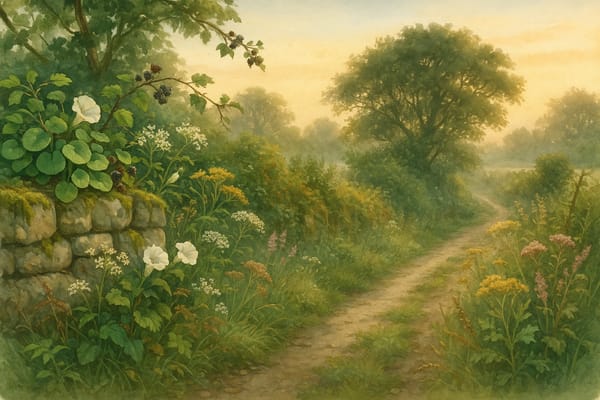Across Cornwall’s patchwork of fields, moorlands, and coastal lanes, the Cornish hedge stands as an enduring icon. Built of stone, shaped by centuries, and alive with plants and wildlife, these living boundaries are far more than rustic charm. They are ecological lifelines, heritage treasures, and versatile garden features.
For gardeners, land stewards, and nature lovers, understanding the layered value of Cornish hedges opens the door to sustainable design, biodiversity support, and climate-smart landscaping.
What Makes a Cornish Hedge Unique?
Unlike traditional hedgerows—lines of woody shrubs often planted in recent centuries—Cornish hedges are ancient, complex structures of stone and earth topped with turf and shrubs. Many date back over 4,000 years, making them among Britain’s oldest living field boundaries.
Their typical construction:
- Stone Faces with Earth Core: Large base stones tapering to smaller stones at the top, with compacted earth between.
- Turf-Capped Top: Often planted with shrubs like hawthorn, blackthorn, or gorse.
- Wildflower and Grass-Covered Sides: Crevices between stones host mosses, ferns, and flowering plants.
Wildlife Corridors & Biodiversity Hotspots
Cornish hedges act as vital wildlife corridors, connecting fragmented habitats across agricultural or developed landscapes. They serve as refuges, foraging routes, and breeding sites for an extraordinary array of species.
Microhabitats in a Single Structure:
| Microhabitat | Description | Key Species |
|---|
| Stone Crevices | Moist, shaded gaps between stones | Mosses, ferns, beetles, snails |
| Earth Banks | Stable soils with sun and shade aspects | Wildflowers, fungi, burrowing mammals |
| Turf-Capped Tops | Dense wildflower and grass mats | Pollinators, birds, butterflies |
| Shrubby Crowns | Woody plants atop the hedge | Nesting birds, bats, invertebrates |
| Damp Bases | Moist areas with ditches or pools | Amphibians, aquatic insects |
This mosaic effect mimics woodland edges, grasslands, rocky outcrops, and even wetlands—often within a single stretch of hedge.
Cornish Hedges in the Garden: Practical & Aesthetic Roles
For the gardener, Cornish hedges offer both functional and ornamental value:
- Natural Rock Gardens: Their stone faces create a vertical flower bed, perfect for native wildflowers, mosses, and lichens.
- Garden Division & Structure: They can divide spaces into 'rooms', support terraces, or create natural screens.
- Wildlife Habitat: Nectar, seeds, shelter, and corridors for pollinators, birds, and mammals.
- Longevity & Low Maintenance: Properly built, they resist wind, weather, and time far better than timber fencing.
Planting & Managing Cornish Hedges for Biodiversity
Planting Tips:
- Expose to Light: Trim overgrowth to allow herbaceous plants to thrive on the sides.
- Sow in Crevices: Fill stone gaps with soil and plug with turf before sowing a pinch of native seeds.
- Use Native Species: Red campion, foxglove, bluebell, hart’s-tongue fern, honeysuckle, ivy, and hawthorn.
- Water & Mulch: Until established, and mulch to suppress weeds.
Ongoing Care:
- Trim Tops Periodically: Prevent dominance of woody plants.
- Avoid Aggressive Groundcovers: Choose species that won’t undermine stonework.
- Rotate Trimming: Vary your trimming regime to retain wildlife cover and flowering.
Ecological & Climate Impact
Cornish hedges offer ecosystem services that rival larger landscape elements:
| Ecosystem Service | Benefit |
|---|
| Carbon Sequestration | Deep soils, dense vegetation, and mosses store significant CO₂ |
| Soil Retention | Prevent erosion, especially on slopes |
| Shelter | Buffer winds, protect crops and livestock |
| Water Management | Reduce runoff and flooding risks |
| Pollination & Pest Control | Support insects that benefit gardens and farms |
| Wildlife Connectivity | Link fragmented habitats for genetic diversity |
In climate terms, Cornish hedges are carbon sinks. Their longevity and habitat stability make them powerful allies in nature-based climate solutions—an essential part of both Cornwall’s and the UK’s climate strategies.
Comparing Cornish Hedges with Traditional Hedgerows
| Feature | Cornish Hedge | Traditional Hedgerow |
|---|
| Core | Stone-faced earth bank | Woody shrubs/trees, sometimes earth bank |
| Age | Often prehistoric | Mostly post-medieval |
| Wildlife Value | Exceptional—multiple microhabitats | High, but less diverse |
| Durability | Centuries to millennia | Needs regular laying, coppicing |
| Carbon Storage | High per footprint | Moderate |
| Microhabitats | Stone, earth, vegetation, wet/dry zones | Mainly woody layers |
While both serve as vital wildlife corridors, Cornish hedges support richer biodiversity thanks to their structure, microclimates, and age.
Best Practice for Hedge Maintenance
- Formative Pruning: Encourage dense early growth.
- Rotate Trimming: Every 2–3 years; avoid cutting all at once.
- Avoid Bird Nesting Season: Best trimmed late winter (February–March).
- Encourage Plant Diversity: Mix of native shrubs and ground flora.
- Rejuvenate Gradually: Remove one-third of old stems annually over three years.
- Inspect for Pests/Disease: Use organic control methods.
- Shape with a Wider Base: Helps light reach all layers and promotes dense growth.
Threats & Conservation Needs
Urban expansion, intensive farming, and overzealous trimming threaten Cornwall’s hedge network. Their survival depends on:
- Respectful Management: Avoiding flail trimming, encouraging traditional maintenance.
- Community Action: Supporting local conservation groups.
- Policy Support: Aligning with UK climate targets to expand hedgerow networks.
A Living Heritage for Future Generations
Cornish hedges are more than boundaries—they are Cornwall’s living, breathing heritage. From their role as biodiversity hotspots and climate mitigators to their contribution to the county’s unique landscape, these ancient structures demand thoughtful care and renewed appreciation.
In your garden, whether as a boundary, backdrop, or wildlife haven, a Cornish hedge connects you to a legacy stretching back millennia—an ever-present reminder that nature, history, and humanity are intertwined along every hedged lane of this remarkable land.











